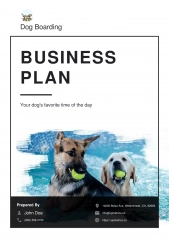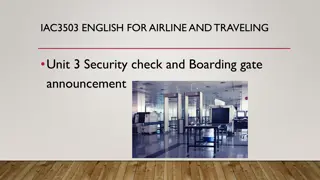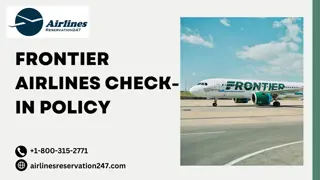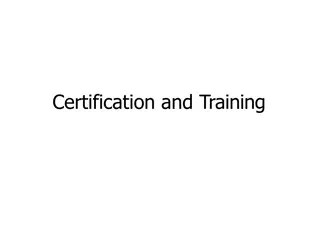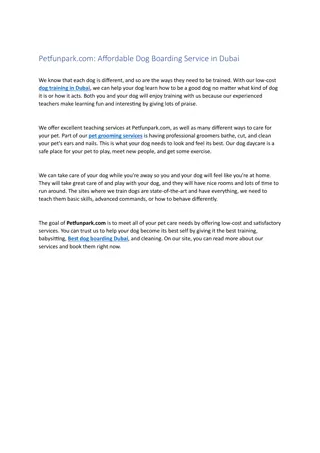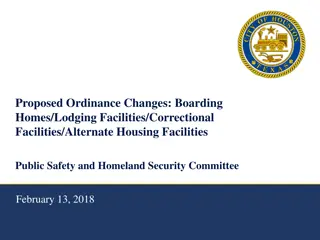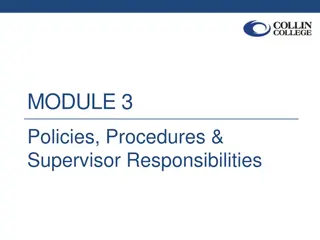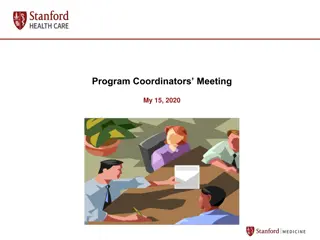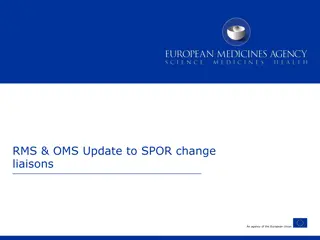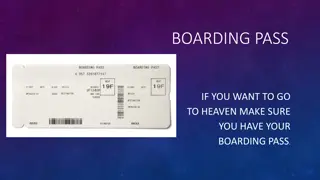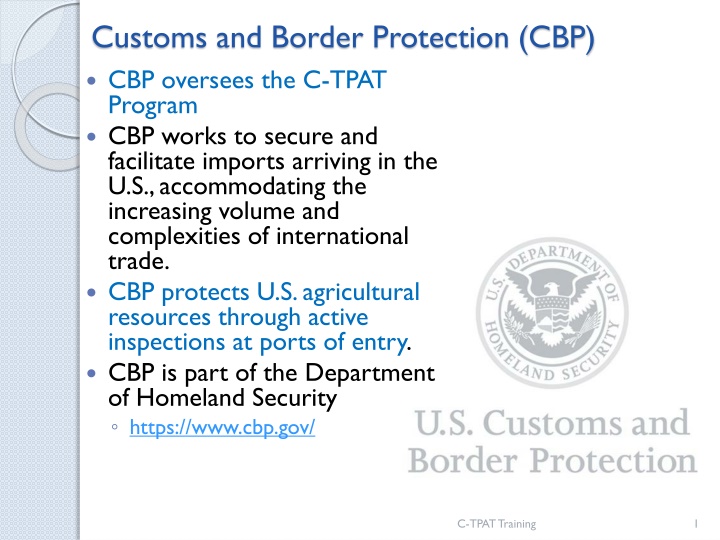
C-TPAT: Supply Chain Security and Threat Mitigation
Learn about the Customs-Trade Partnership Against Terrorism (C-TPAT) program overseen by Customs and Border Protection (CBP). Discover how C-TPAT strengthens supply chain security, who is involved, participation requirements, and threats it addresses like terrorism and cargo theft. Understand how criminals bypass security measures.
Uploaded on | 2 Views
Download Presentation

Please find below an Image/Link to download the presentation.
The content on the website is provided AS IS for your information and personal use only. It may not be sold, licensed, or shared on other websites without obtaining consent from the author. If you encounter any issues during the download, it is possible that the publisher has removed the file from their server.
You are allowed to download the files provided on this website for personal or commercial use, subject to the condition that they are used lawfully. All files are the property of their respective owners.
The content on the website is provided AS IS for your information and personal use only. It may not be sold, licensed, or shared on other websites without obtaining consent from the author.
E N D
Presentation Transcript
Customs and Border Protection (CBP) CBP oversees the C-TPAT Program CBP works to secure and facilitate imports arriving in the U.S., accommodating the increasing volume and complexities of international trade. CBP protects U.S. agricultural resources through active inspections at ports of entry. CBP is part of the Department of Homeland Security https://www.cbp.gov/ C-TPAT Training 1
What is C-TPAT? The Customs-Trade Partnership Against Terrorism (C-TPAT) is a voluntary program initiative to help protect the United States after September 11, 2001 C-TPAT started in 2003 with voluntary applications for importers, carriers, brokers, and freight forwarders Currently C-TPAT has about 11,500 members including importers, consolidators, sea carriers, port terminals and foreign manufacturers C-TPAT Training 2
What is C-TPAT? A joint government business initiative to build cooperative relationships that strengthen the overall supply chain and border security Customs recognizes that they can only be successful with industry cooperation www.cbp.gov www.dhs.gov C-TPAT Training 3
Who Is Part of the Supply Chain? NVOCC s Cargo Handlers Inspectors Fumigators Government Agencies Freight Forwarders Longshoremen Customs Brokers Importers 4 C-TPAT Training
What Does Participation in C- TPAT Require? Self-assessment of supply chain security using C-TPAT best practice guidelines Business Partner Requirements Cargo Security Container Security Physical Access Controls Personnel Security Procedural Security Security Training and Threat Awareness Physical Security Information Technology Security C-TPAT Training 5
What are the Threats? Terrorism, sabotage Trafficking drugs; conventional, nuclear, chemical or biological weapons Illegal entry stowaways in containers, trailers Theft of cargo, personal property or information C-TPAT Training 6
How Criminals Circumvent Security Measures Loitering near the facility observing procedures, asking questions Taking pictures, obtaining plans or making diagrams of facilities Impersonating workers, e.g., pest control Calling or e-mailing employees about procedures C-TPAT Training 7
Securing the Supply Chain at Konica Minolta Educate employees Know our partners due diligence Create and share our security policy expectations Use C-TPAT certified service providers Implement a security policy and procedures Secure our facilities, systems and conveyances Be conscious of security day to day C-TPAT Training 8
YOUR Facility: Emergency Guidelines Know your safe room and/or location Know what to do if there is a Hazmat Situation or other threat situation Know where to meet outside the facility in case of evacuation Know the numbers to call C-TPAT Training 9
Securing the Supply Chain at Konica Minolta Challenge unfamiliar or unidentified visitors in the office or warehouse Don t share system passwords Report any suspected or actual irregularity or illegal activity to management C-TPAT Training 10
Securing the Supply Chain at Konica Minolta Report potential security risks to management, e.g. ,broken lock, fence, security light, missing keys and access cards, damage to alarm, or video surveillance systems, etc. Report any unauthorized personnel, or use of access cards by unauthorized personnel Report any paperwork discrepancies Don t share confidential and proprietary information outside Konica Minolta Be wary of outside requests for information about company policies, procedures, assets, etc. C-TPAT Training 11
Recognizing Potential Security Risk Activity out of the norm Loitering out of normal sight lines Attempts to bypass security Clothing not suited for weather Noises or odors not expected from containers Containers with holes, patches, missing or damaged seals or seal numbers that don t match Incorrect Hazmat labels for cargo Can you think of others? C-TPAT Training 12
Physical Access Controls IMPORTANT AREA OF EMPLOYEE PARTICIPATION Employees should know fellow co-workers and challenge unauthorized personnel to identify themselves when seen on the premises. Employees should notify the head of security about any unauthorized personnel on premises. C-TPAT Training 13
Physical Access Controls Employees must wear badges at all time and should report cases where: Visitors and delivery personnel are not wearing identifying badges while on premises Any proposed break in procedure (I just need to drop something off) C-TPAT Training 14
Personnel Security Human Resources is responsible for verifying previous employment, background checks, and termination procedures Employees should immediately report if terminated employees try to access the facilities, company systems, etc. C-TPAT Training 15
Procedural Security Shipping employees must: Inspect trailer before loading for any damage 7 point test, especially if trailer was in storage Verify paperwork and seal number Cargo integrity (correct quantity, weight, description) Properly affix seal(s) Report any sign of tampering or suspicious activity Follow written procedures: keep logs updated C-TPAT Training 16
Procedural Security Receiving employees must: Verify that cargo specifications match paperwork; Verify seal number; Check for exterior signs of tampering; After unloading, check interior for tampering; Report any signs of tampering or suspicious activity; Make sure container/trailer is properly reloaded or stored; Follow all written procedures: keep all logs updated; C-TPAT Training 17
Business Partner Requirements All business partners (manufacturers, suppliers, vendors) should meet C-TPAT criteria or equivalent foreign supply chain security system. All international business partners must complete Konica Minolta s C-TPAT questionnaire. C-TPAT Training 18
Documentation Fraud Fraud involves the use of dishonest or deceitful conduct in order to obtain some unjust advantage over someone else. C-TPAT Training 19
Documentation Fraud Three ways to limit fraud: Reduce the supply of motivated offenders; Protect and educate the targets; Limit opportunities by making the crime difficult to commit; How to detect fraud Look for anomalies, e.g., changes in lifestyle, valuation or description on documentation, increase in claims, etc. C-TPAT Training 20

